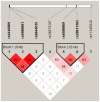Sequencing ASMT identifies rare mutations in Chinese Han patients with autism
- PMID: 23349736
- PMCID: PMC3547942
- DOI: 10.1371/journal.pone.0053727
Sequencing ASMT identifies rare mutations in Chinese Han patients with autism
Abstract
Melatonin is involved in the regulation of circadian and seasonal rhythms and immune function. Prior research reported low melatonin levels in autism spectrum disorders (ASD). ASMT located in pseudo-autosomal region 1 encodes the last enzyme of the melatonin biosynthesis pathway. A previous study reported an association between ASD and single nucleotide polymorphisms (SNPs) rs4446909 and rs5989681 located in the promoter of ASMT. Furthermore, rare deleterious mutations were identified in a subset of patients. To investigate the association between ASMT and autism, we sequenced all ASMT exons and its neighboring region in 398 Chinese Han individuals with autism and 437 healthy controls. Although our study did not detect significant differences of genotypic distribution and allele frequencies of the common SNPs in ASMT between patients with autism and healthy controls, we identified new rare coding mutations of ASMT. Among these rare variants, 4 were exclusively detected in patients with autism including a stop mutation (p.R115W, p.V166I, p.V179G, and p.W257X). These four coding variants were observed in 6 of 398 (1.51%) patients with autism and none in 437 controls (Chi-Square test, Continuity Correction p = 0.032, two-sided). Functional prediction of impact of amino acid showed that p.R115W might affect protein function. These results indicate that ASMT might be a susceptibility gene for autism. Further studies in larger samples are needed to better understand the degree of variation in this gene as well as to understand the biochemical and clinical impacts of ASMT/melatonin deficiency.
Conflict of interest statement
Figures


Similar articles
-
Abnormal melatonin synthesis in autism spectrum disorders.Mol Psychiatry. 2008 Jan;13(1):90-8. doi: 10.1038/sj.mp.4002016. Epub 2007 May 15. Mol Psychiatry. 2008. PMID: 17505466 Free PMC article.
-
Genetic and functional abnormalities of the melatonin biosynthesis pathway in patients with bipolar disorder.Hum Mol Genet. 2012 Sep 15;21(18):4030-7. doi: 10.1093/hmg/dds227. Epub 2012 Jun 13. Hum Mol Genet. 2012. PMID: 22694957
-
Association between ASMT and autistic-like traits in children from a Swedish nationwide cohort.Psychiatr Genet. 2014 Feb;24(1):21-7. doi: 10.1097/YPG.0000000000000010. Psychiatr Genet. 2014. PMID: 23995775
-
Mutation screening of ASMT, the last enzyme of the melatonin pathway, in a large sample of patients with intellectual disability.BMC Med Genet. 2011 Jan 20;12:17. doi: 10.1186/1471-2350-12-17. BMC Med Genet. 2011. PMID: 21251267 Free PMC article.
-
[Association of polymorphic variants of DDC (AADC), AANAT and ASMT genes encoding enzymes for melatonin synthesis with the higher risk of neuropsychiatric disorders].Zh Nevrol Psikhiatr Im S S Korsakova. 2021;121(5):151-157. doi: 10.17116/jnevro2021121041151. Zh Nevrol Psikhiatr Im S S Korsakova. 2021. PMID: 34184492 Review. Russian.
Cited by
-
Chromosomal microarray and whole-exome sequence analysis in Taiwanese patients with autism spectrum disorder.Mol Genet Genomic Med. 2019 Dec;7(12):e996. doi: 10.1002/mgg3.996. Epub 2019 Oct 8. Mol Genet Genomic Med. 2019. PMID: 31595719 Free PMC article.
-
A Comparative Genomics Study on the Molecular Evolution of Serotonin/Melatonin Biosynthesizing Enzymes in Vertebrates.Front Mol Biosci. 2020 Feb 4;7:11. doi: 10.3389/fmolb.2020.00011. eCollection 2020. Front Mol Biosci. 2020. PMID: 32118037 Free PMC article. Review.
-
Melatonin in children with autism spectrum disorders: endogenous and pharmacokinetic profiles in relation to sleep.J Autism Dev Disord. 2014 Oct;44(10):2525-35. doi: 10.1007/s10803-014-2123-9. J Autism Dev Disord. 2014. PMID: 24752680 Free PMC article.
-
Melatonin in Children with Autism Spectrum Disorders: How Does the Evidence Fit Together?J Nat Sci. 2015;1(7):e125. J Nat Sci. 2015. PMID: 26120597 Free PMC article.
-
Coherent somatic mutation in autoimmune disease.PLoS One. 2014 Jul 2;9(7):e101093. doi: 10.1371/journal.pone.0101093. eCollection 2014. PLoS One. 2014. PMID: 24988487 Free PMC article. Review.
References
-
- Rutter M (2000) Genetic studies of autism: from the 1970s into the millennium. J Abnorm Child Psychol 28: 3–14. - PubMed
-
- Folstein SE, Rosen-Sheidley B (2001) Genetics of autism: complex aetiology for a heterogeneous disorder. Nat Rev Genet 2: 943–955. - PubMed
-
- Veenstra-Vanderweele J, Cook E Jr, Lombroso PJ (2003) Genetics of childhood disorders: XLVI. Autism, part 5: genetics of autism. J Am Acad Child Adolesc Psychiatry 42: 116–118. - PubMed
-
- McCarthy MI, Abecasis GR, Cardon LR, Goldstein DB, Little J, et al. (2008) Genome-wide association studies for complex traits: consensus, uncertainty and challenges. Nat Rev Genet 9: 356–369. - PubMed
Publication types
MeSH terms
Substances
LinkOut - more resources
Full Text Sources
Other Literature Sources
Molecular Biology Databases

